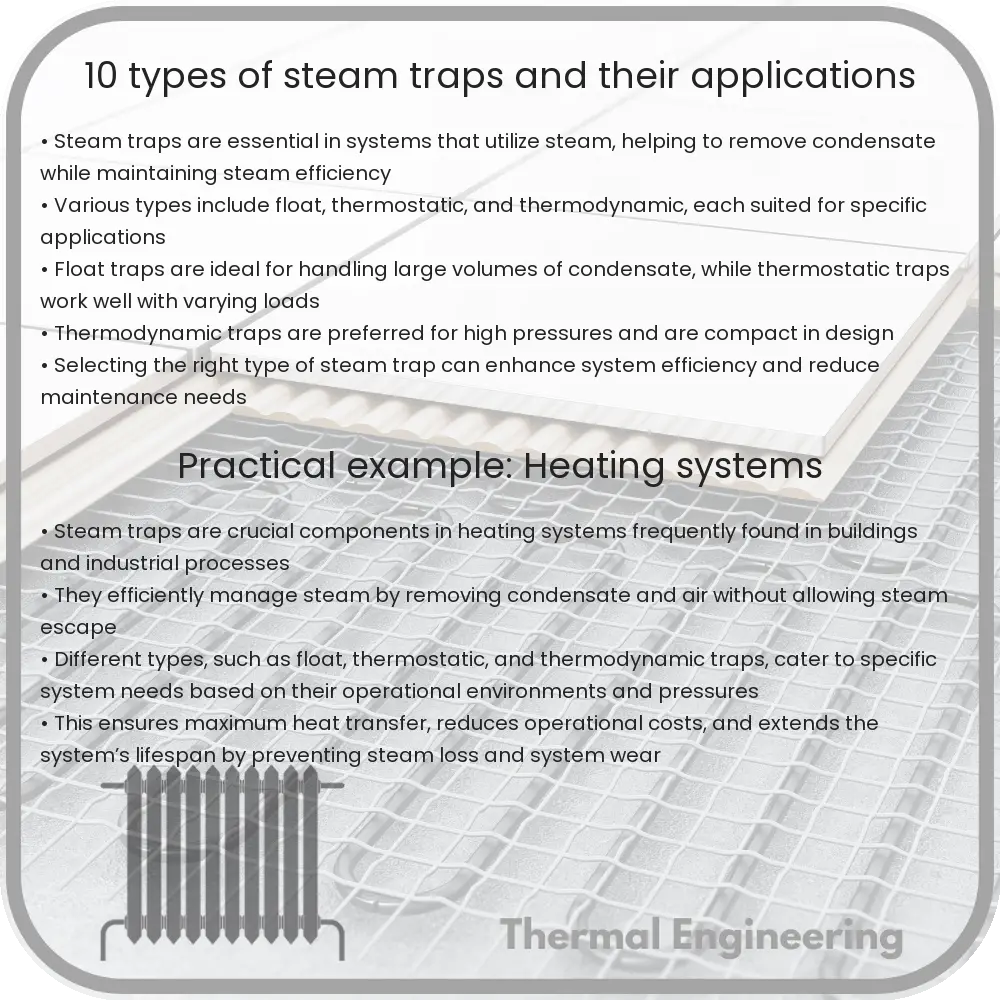Learn about steam traps, their crucial role in steam systems for energy efficiency and safety, and explore the different types used across various applications.

Understanding Steam Traps and Their Varieties
A steam trap is a device used to discharge condensate and non-condensable gases with a negligible consumption or loss of live steam. They are a critical component of steam systems and are vital in reducing energy loss, increasing efficiency, and improving system safety. There are several types of steam traps, each suited to specific operating conditions and applications. Below, we explore 10 common varieties of steam traps and their typical uses.
Types of Steam Traps
1. Mechanical Traps
- Float Traps: These use a float ball that rises and falls in response to the condensate level, opening or closing the valve. They are effective in handling high capacities of condensate and are primarily used in applications where efficient heat transfer is necessary.
- Inverted Bucket Traps: Rely on an inverted bucket that floats on the condensate and drops when steam arrives, sealing the trap. Suitable for high-pressure applications and notable for their durability.
2. Thermostatic Traps
- Bimetallic Traps: Utilize bimetallic strips that bend with temperature changes, opening or closing the trap. Ideal for use with superheated steam.
- Wax Thermostatic Element Traps: These traps operate using a wax element that expands and contracts with temperature variations to open or close the valve. Commonly used in lighter applications where minimal condensate is produced.
- Bellows Traps: Feature a bellows filled with vapor pressure that expands or contracts with changing temperatures, making them suitable for applications with a steady range of temperatures.
3. Thermodynamic Traps
- Disc Traps: Operate using a disc that moves up and down due to pressure fluctuations, allowing for the quick removal of condensate. These traps are compact and have a high tolerance for water hammer and corrosion.
4. Venturi Traps
- Orifice Traps: Contain a fixed orifice and operate without moving parts, controlling flow through a variable orifice depending on the condensate load. They are known for their simplicity and low maintenance.
5. Specialized Traps
- Impulse Traps: Utilize the kinetic energy of flash steam to operate valves. These types of traps are often employed where high efficiency is required and differential pressure is available.
- Bi-Thermostatic Traps: Combine a bimetallic element and a bellows to handle varying conditions, frequently found in steam heating systems and drying cylinders.
- Ball Float Traps: Similar to float traps but use a ball instead of a float. These are typically used in heavy-duty applications, handling large volumes of condensate efficiently.
- Radiator Traps: Designed specifically for radiators, these traps use a thermostatic element to discharge condensate once it cools below steam temperature.
- F&T (Float and Thermostatic) Traps: Combine the features of float traps with a thermostatic release of air, offering a mixture of capabilities ideal for heating applications and unit heaters.
Applications of Steam Traps
Steam traps are integral to the efficiency and safety of steam distribution systems. They are utilized in various applications, including heating installations, large steam systems in chemical plants, and power stations. Each type of steam trap is chosen based on specific factors like operating pressure, temperature conditions, required discharge capacity, and presence of non-condensable gases. Identifying and implementing the right kind of steam trap ensures optimal system performance and can substantially reduce energy costs.
Understanding these different types of steam traps and their applications provides a solid foundation in managing and maintaining a robust and efficient steam system. While choices can vary based on specific industry needs, the fundamental principles of condensate removal and energy efficiency remain constant, ensuring that steam systems across various applications continue to operate effectively.